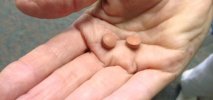New Treatment for Macular holes
Recent approval of Jetrea (Ocriplasmin) to treat symptomatic VMA (Vitreo Macular Adhesion) has opened up a new era in non surgical management of macular holes. Previously only a hospital based surgery was able to reverse the process of macular hole development but now a new drug can be injected into the eye painlessly in the office and within a few weeks the process reverses back to more normal vision levels.... more
FDA Approves ASRS Leader's ArgusŪ II Artificial Retina
On February 14, the FDA approved the Argus II artificial retina developed by ASRS Executive Committee and Board Member Mark S. Humayun, MD, PhD.
This breakthrough technology is the first ever to offer limited vision to patients with late-stage retinitis pigmentosa (RP).
Second Sight Medical Products (Sylmar, CA) manufactures the Argus II implant, which has 60 electrodes and a tiny camera mounted on eyeglasses to capture images.
The FDA approved Argus II for adults age 25 years or older with severe to profound RP. About 10,000 to 15,000 of the 100,000 Americans with RP will qualify for Argus II. Up to 4,000 patients a year can be treated with the device.
Macular degeneration and Aspirin?

Aspirin and Macular degeneration... is there an increase in the wet form of macular degeneration in those patients taking aspirin? The wet form develops quicker than the dry form. It may only be related to the fact that you are more likely to take aspirin if you have medical problems like stroke or heart attacks in the past and these conditions are more commonly associated with wet age related macular degeneration. ... more

Pneumatic Retinopexy
Overview:
When the retina detaches from the back wall of the eye, it will degenerate rapidly without the proper blood supply and nutrition. Most tears that lead to retinal detachments occur in the peripheral retina, and therefore cause in a loss of peripheral vision first. It is of the utmost importance to discover a retinal detachment before the macula detaches and all central vision is lost. Pneumatic retinopexy is an effective procedure to treat retinal detachments that occur as a result of a break or a tear. It is usually reserved for early single superior tears. This is a two step process: put the retina back in place with the gas bubble, when it is there, seal the tear with laser or cryotherapy.
Process:
Pneumatic retinopexy is performed in-office at East Carolina Retina Consultants. You will remain awake for the procedure, but be administered local anesthesia on or near the affected eye. During the procedure, a gas or air bubble is injected into the vitreous cavity in the middle of your eye. Because gas is lighter than liquids or solids, the bubble floats to the detached area, filling the space of the tear and flattening the retina against the wall of the eye. Your physician will most likely need to position your head to ensure that the bubble reaches the tear and will give you instructions on how to maintain a position to keep the bubble in place until it is absorbed by your body over the next 2-4 weeks. When a pneumatic retinopexy is successful, the subretinal fluid usually resolves itself within 1-2 days. Either at the time of pneumatic retinopexy or a few days later, cryotherapy or laser will be needed to seal the retinal tear. Further positioning is needed to keep the tear closed so that it can heal. excessive activity in the first two weeks post treatment will cause the procedure to fail and need hospital surgery.
Following the procedure, your eye will be red, puffy and teary and you may experience some mild pain. Your physician will send you home with a prescription for pain medications that can be taken if needed and you may be given steroid eye drops as well. When you return the day after the procedure to have your patch removed from your eye, your physician may elect to perform another treatment using a laser or cryotherapy.
Benefits:
- Pneumatic retinopexy is done in-office at East Carolina Retina Consultants and under local anesthesia only.
- Chances of recovering good vision after surgery is high and usually better than other procedures that fix retinal detachments.
- There is about an 80% reattachment rate for single superior tear fresh retinal detachment.
- If it fails for whatever reason, doing Pneumatic retinopexy does not reduce the overall sucess rate of other procedures that would be needed.
Risks:
- Precise head positioning is required for 7-10 days following the procedure.
- Some rare, but possible complications include: cataract formation, glaucoma, gas getting under the retina, excessive scar tissue formation and infection.
- Approximately a 20% chance of needing further procedures to save the eye and vision.
- Best vision may not return until months following surgery.






